Previous issue | Next issue | Archive
Volume 6 (3); September 25, 2016 [Booklet]
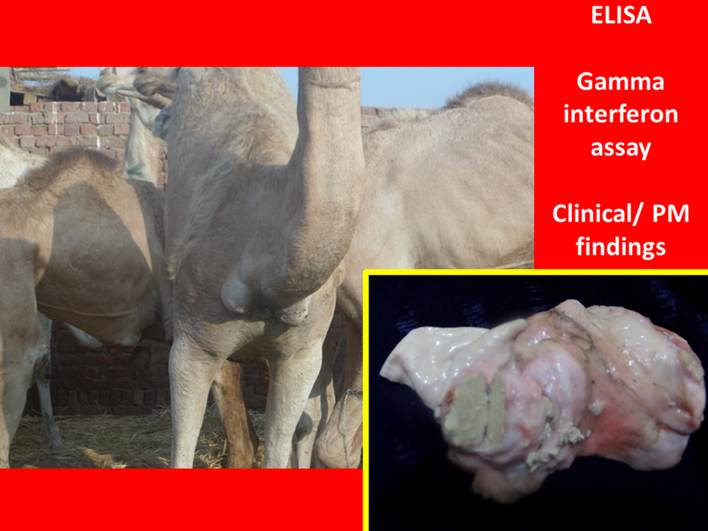 Research Paper
Research Paper
Serological Surveillance of Caseous Lymphadenitis in Sudanese and Somali Camels Slaughtered at Al-warraq Abattoir, Giza, Egypt.
Ahmed Borham M, Atef Fatehy Oreiby, Abd-Allah El-Gedawy A and Hassanein Al-Gaabary M.
World Vet. J. 6(3): 89-94, 2016; pii:S232245681600013-6
DOI: http://dx.doi.org/10.5455/wvj.20160872
ABSTRACT
Caseous lymphadenitis is an economically important bacterial disease of camels and small ruminants worldwide. This study is designed for the surveillance of caseous lymphadenitis in Sudanese and Somali camels slaughtered at Al-Warraq abattoir, Giza, Egypt during the period from January to November 2015. A total of 93 camels were subjected to clinical, postmortem examinations and tested by two enzyme-linked immunosorbent assays based on Corynebacterium pseudotuberculosis exotoxin and sonicated whole cell antigens. In addition, the validity of bovine tuberculosis gamma interferon assay to diagnose caseous lymphadenitis in camels was tested which is reported previously in small ruminants, but not in camels. Suspected caseous lymphadenitis lesions were detected in 33 (35.4%) camels compared to seropositivity percentage of 58.06% and 61.29% by exotoxin and sonicated whole cell antigen enzyme-linked immunosorbent assays, respectively. All lesion-affected camels were seropositive except for one animal (3.03%). On the contrary, only 25% of the lesion free camels were seronegative. There was no increase in gamma interferon assay optical density values of four caseous lymphadenitis confirmed cases in response to increased concentration of the stimulating exotoxin antigen. In conclusion, caseous lymphadenitis is prevalent among Sudanese and Somali camels imported for meat consumption in Egypt. Presence of a detectable lesion is highly indicative for seropositivity, but its absence does not indicate seronegativity. In addition, bovine tuberculosis gamma interferon assay has no value to diagnose caseous lymphadenitis in camels.
Key words: Caseous, Lymphadenitis, Camels, Serological, Survey.
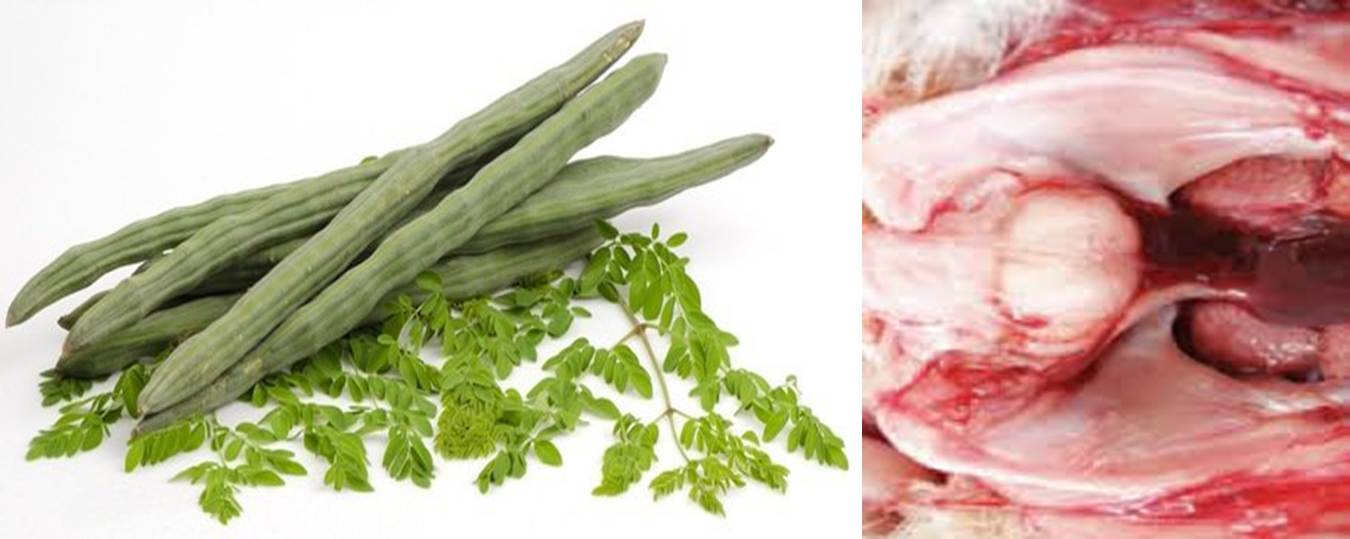 Research Paper
Research Paper
The Effect of Very Virulent Infectious Bursal Disease Virus on Immune Organs of Broilers Fed Moringa Oleifera Supplemented Feed.
Balami Arhyel G, Abdu Paul A, Wakawa Aliyu M, Aluwong T.
World Vet. J. 6(3): 95-100, 2016; pii:S232245681600014-6
DOI: http://dx.doi.org/10.5455/wvj.20160873
ABSTRACT
A study was conducted to evaluate the immune modulating effect of Moringa Oleifera Leave (MOL) feed supplementation in broilers. 240 day old Ross 308 hybrid broiler chicks were assigned into four groups (A, B, C and D) of 60 chicks each in a deep litter house. Groups A and B were fed with formulated broiler starter and broiler finisher feeds containing 5% MOL for 28 and 21 days, respectively, while groups C and D were fed with formulated broiler starter and broiler finisher feed without MOL for 28 and 21 days, respectively. Broilers in groups A and C were vaccinated intramuscularly with 0.5 ml of an inactivated vaccine of intermediate strain of Infectious Bursal Disease (IBD) at 14 and 21 days of age, respectively. Broilers in groups A, B and C were challenged intraocularly at 35 days of age with 0.05 ml of a live very virulent Infectious Bursal Disease Virus (vvIBDV). The Thymus to Body Index (TBI) of birds in group A was 1.09, 1.05 and 1.03 at 35, 38 and 42 days of age respectively, while those in group B had a TBI of 0.84, 1.02 and 0.89 at 35, 38 and 42 days of age respectively. The TBI of birds in group C were 1.04, 1.22 and 1.29 at 35, 38 and 42 days of age respectively, however, there was significant difference between group B and C (P< 0.02). Moringa oleifera leaves feed supplementation improved the bursa, spleen, harderian and thymus to body weight index of broilers. The MOL feed supplementation and inactivated vaccine did not prevent the atrophy of bursa, spleen and harderian gland against the negative effect of vvIBDV 7 days post infection.
Keywords: Broilers, Immune organs, Infectious bursal disease virus, Organ to body weight index, Moringa oleifera
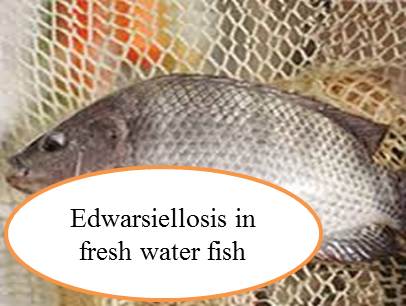 Research Paper
Research PaperInsight into the Virulence-Related Genes of Edwardsiella Tarda Isolated from Cultured Freshwater Fish in Egypt.
Moustafa Moustafa E, Alaa El-Dein Omar A and Sobhy Abdo W.
World Vet. J. 6(3): 101-109, 2016; pii:S232245681600015-6
DOI: http://dx.doi.org/10.5455/wvj.20160874
ABSTRACT
One of the most serious fish pathogens infecting both cultured and wild fish species was found to be Edwardsiella tarda which contains important virulence factors that enhance bacterial survival and pathogenesis in hosts. The present study aims to isolate, identify and characterize E. tarda in freshwater fishes in Kafr El-Sheikh governorate, Egypt using selective differential cultural medium (Rimler Shotts agar), morphological and biochemical tests (oxidase, catalase, methyl red, voges proskauer, indole, citrate utilization, gelatine hydrolysis, H2S production, oxidation-fermentation, nitrate reduction and sugar utilization tests). Pathogenesis of E. tarda was checked by experimental infection to Oreochromis niloticus fish together with screening of the highly virulent three virulence genes (esrB, mukF and gadB). The obtained results revealed the presence of the three virulence genes in the selected strain of E. tarda which gave severe lesions in the experimentally infected Oreochromis niloticus. E. tarda strain having more than one virulence gene results in more severe lesions than strains having one or even no virulence genes.
Key words: Edwardsiella tarda, Virulence genes, Freshwater fish
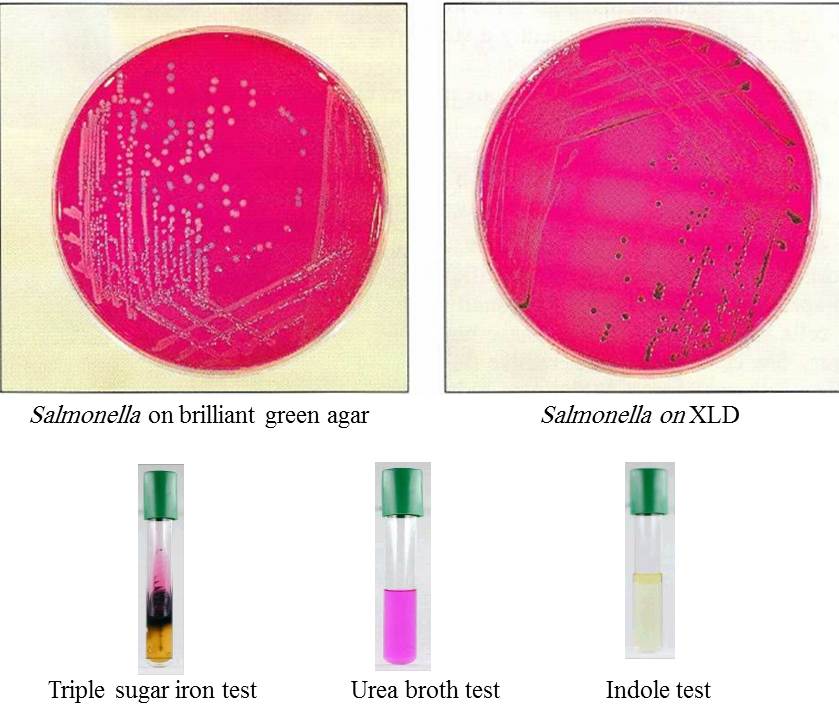 Research Paper
Research Paper
Prevalence of Antimicrobial Resistant Salmonellae Isolated From Bulk Milk of Dairy Cows in and Around Debre Zeit, Ethiopia.
Mossie T and Dires A.
World Vet. J. 6(3): 110-116, 2016; pii:S232245681600016-6
DOI: http://dx.doi.org/10.5455/wvj.20160875
ABSTRACT
A cross sectional study to determine the prevalence and antimicrobial resistant profile of Salmonella isolates from 106 bulk milk of dairy cows was undertaken from December 2013 to April 2014 in supermarket, large and small holder’s dairy farms in Debre Zeit, Ethiopia. The bacteria was isolated and identified according to standard methods and sensitivity tests were done by the Kirby-Bauer disc diffusion method. The study revealed an overall prevalence of 23.6% (25/106). The occurrence of salmonella in large and small scale farm was 20.4% and 27.3% respectively. The isolated Salmonella spp. was resistant to at least two or more antimicrobials which were used in this study. A higher proportion of the isolates (96%) were resistant to ampicillin and the lowest resistance was recorded for streptomycin (8%). Assay of antimicrobial resistance revealed that 96% of Salmonella isolates were resistant to two or more of the nine antimicrobials tested whereas 4% of the isolate was sensitive. The most common resistance was to Ampicillin 24 (96%), oxytetracycline 21 (84%), amoxicillin 12 (48%), Chloramphenicol 10 (40%). A significant proportion has developed resistance for routinely prescribed antimicrobial drugs both in veterinary and public health sectors. This poses considerable health hazards to the consumers unless prudent antimicrobial usage, adequate heat treatment, improvement of standards of hygiene and development and enforcement of suitable legislation, which safeguard consumers, are urgently instituted.
Key words: Isolates, Salmonella, Prevalence, Antimicrobial resistance, Bulk milk sample
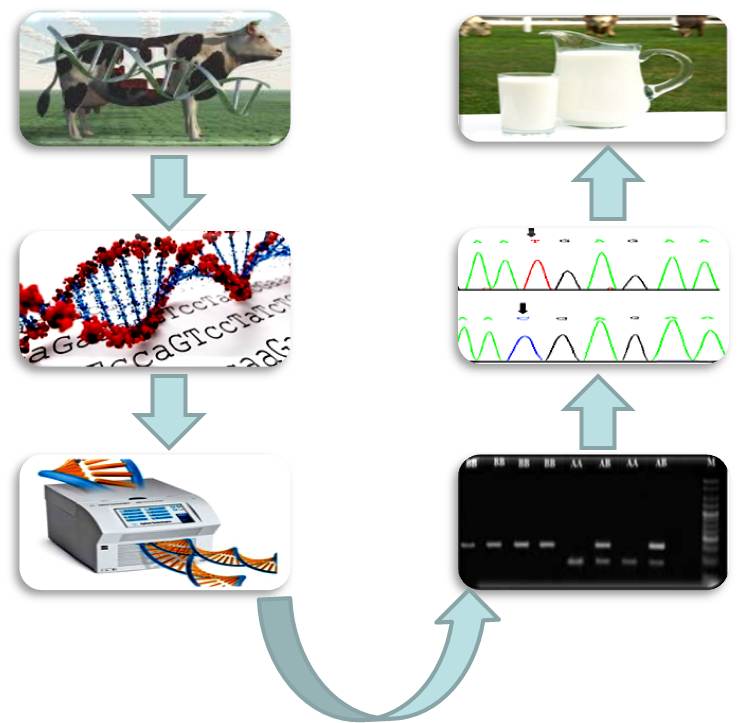
Research Paper
Association of β –Lactoglobulin Gene Polymorphism with Milk Yield, Fat and Protein in Holstein-Friesian Cattle.
Wageh Zaglool A, Awad A, El sayed El Araby I and Mohamed El-Bayomi Kh.
World Vet. J. 6(3): 117-122, 2016; pii:S232245681600017-6
DOI: http://dx.doi.org/10.5455/wvj.20160876
ABSTRACT
Improving the efficiency of milk production and its constituents without increasing the size of the dairy herd is the foremost goal of the selection in dairy industry. The use of polymorphic genes as detectable molecular markers is a promising alternative to the current methods of trait selection once these genes are proven to be associated with traits of interest in animals. Beta-lactoglobulin (Β-LG) is one of the most important genes that play a crucial role in the milk quality and coagulation process of cheese and butter. Identification of different Β-LG genotypes and association with different milk performance traits in Egyptian Holstein cattle was performed through Polymerase Chain Reaction-Restriction Fragment Length Polymorphism (PCR-RFLP) and DNA sequencing of two hundred blood samples. Digestion of 447bp PCR product with Hae III restriction enzyme revealed three genotypes (AA, AB, BB), with higher frequency of B allele (64%) than A allele (36%). Nucleotide sequence analysis of different genotypes revealed two point mutation at exon four, one of them (T301C) corresponding to the same amino acid asparagine and the other Single Nucleotide Polymorphism (SNP) (C390T) represented a non-synonymous mutation producing amino acid change of alanine to valine. Animals with genotype AA had more milk yield and protein % (11461kg and 3.45) respectively, while BB genotype recorded higher fat % (3.85). The information given in the present study will be extremely helpful for improving milk production traits in dairy cattle by marker-assisted selection and outlined a strategy to avoid long and costly traditional selection methods for dairy purposes in Holstein cattle
Key words: Β-LG polymorphism, PCR- RFLP, Milk production, Holstein Friesian cattle
Research Paper
Rabies in Animals with Emphasis on Dog and Cat in Ethiopia, Sindh, Pakistan.
Kidane AH, Sefir D, Bejiga T, Deressa A and Pal M.
World Vet. J. 6(3): 123-129, 2016; pii:S232245681600018-6
DOI: http://dx.doi.org/10.5455/wvj.20160877
ABSTRACT
Rabies is a major viral anthropozoonosis of public health significance. The animals play a crucial role in maintenance and circulation of the rabies virus. Determining the occurrence of rabies in animals was implicated as a fundamental step to guide prevention and control efforts. The study involved cross sectional study by retrieval previously recorded cases between September 2009 and January 2012, Ethiopia. Suspected animal rabies cases were quarantined for 10 days observation period and brain samples were tested for confirmation using direct fluorescent antibody test. The statistical analysis was performed using SPSS program and Chi-square and analysis of vari¬ance (ANOVA) was used to assess the significance difference. Domestic and wild animals were associated with human exposure and death cases. However, dogs were the culprit for the highest human fatal (97%) and human exposure cases (89.5%). Only 2% of human deaths were associated with cats and wild animals. Higher rabies positivity was noted in owned dogs 138 (74.2%) than ownerless ones 49 (25.8%). The difference was statistically significant (p=0.0001). Further, all positive cases in cats were apparent in those believed to be owned. Majority of positive results associated with dogs were aged above 12 months 70 (81.4%), 10 (11.6%) were from the age between 6 and 12 months followed by 3 to 6 months 6 (7%). Positive cases in cats were more common among those aged above 12 months (60%) followed by 6 to 12 (20%) and 3 to 6 months (20%) of age. Of the animals with positive results, 4 (1.6%) were vaccinated against rabies. Overall, majority of the dogs had no vaccination history 247 (96.1%), only 10 (3.9%) were found to have been vaccinated. On contrary, none of the cats were vaccinated against rabies. The number of submitted samples had a direct correlation with the number of positive results (p< 0.05), however, no season variation was encountered. Five sub-cities that border with another region showed a significantly higher occurrence (p< 0.05) of exposure and confirmed cases and post exposure prophylaxis. Thus, integrated implementation of compulsory animal management, immunization and creation of awareness is highly imperative.
Key words: Addis Ababa, Cat, Dog, Immunization, Rabies, Zoonosis
Research Paper
Effect of Stocking Density and Bird Age on Air Ammonia, Performance and Blood Parameters of Broilers.
Ali Abouelenien F, Khalf-Alla F, Mousa-Balabel T, El-Midany S and Abd el-Latif Nasser M.
World Vet. J. 6(3): 130-136, 2016; pii:S232245681600019-6
DOI: http://dx.doi.org/10.5455/wvj.20160878
ABSTRACT
Current study was conducted to recompense this deficiency through detection of ammonia (NH3) in air samples taken from different groups at different SD and different ages. Additionally the effect of stocking density on stress indicators and broiler performance were studied. A total of 200 unsexed one day old chicks, purchased from a commercial hatchery at Kafr El-Sheikh city, Egypt, were used in this study. The birds were randomly divided into four groups according to SD. These experimental groups were divided as follows: the first group (G1) contains 10 bird/ m2, the second group (G2) contains 14 bird/ m2, the third group (G3) contains 17 bird/ m2 and the fourth group (G4) contains 60 chicks was kept in an area of 3 m2 with SD of 20 bird/ m2. The chicken in all groups (from day 7 to day 42) was raised on deep litter system and received the same standard management, hygienic and environmental conditions. Comparing ammonia concentrations of different SD, the highest ammonia concentration was found in G4 (maximum of 31.4 mgL-1 at 36 day age) while the lowest were found in G1 (10 bird/m2) (0.7, 3.1, 3.5 and 3.5 mgL-1 at 14, 21, 28 and 36 day age respectively). Increased SD tended to reduce the final Body Weight and Body Weight Gain significantly. On the other hand, the relative weights of spleen and bursa were increased significantly (P < 0.05) with increasing SD. In the current study there was a significant difference (P < 0.05) in Total Leukocitic Count, Heterophils %, Lymphocytes %, and H/L ratio between different SD. H/L ratio was highest in G4 (0.192%) and lowest in G1 (0.018%) which showed Increasing in H/L ratio with increase in SD that reflects increase in stress level.
Key words: Broiler, Socking density, Air ammonia, Boiler performance, Bood parameter
Research Paper
Prevalence of Cysticercus Tenuicollis in Small Ruminants Slaughtered at Addis Ababa Abattoir, Ethiopia.
Bejiga T, Haile A, Solomon T, Sefir D and Pal M.
World Vet. J. 6(3): 137-142, 2016; pii:S232245681600020-6
DOI: http://dx.doi.org/10.5455/wvj.20160879
ABSTRACT
Parasitic diseases in general and Cysticercus tenuicollis in particular are responsible for the low productivity of livestock. A study to determine the prevalence of C. tenuicollis in sheep and goats at Addis Ababa abattoir, Ethiopia. A cross sectional study was conducted and a stratified random sampling technique was employed where by sheep and goats to be slaughtered were categorized into two groups based on their sex (male and female) and also based on their age (young and adult) only in case of sheep. The statistical analysis was performed using SPSS program and Chi square. The overall prevalence of C. tenuicollis from 900 shoats was found to be at 355 (39%). Out of the 600 sheep inspected C. tenuicollis was detected in 223 (37.2%) and from 300 inspected goats C. tenuicollis was observed in 132 (44%). The age wise prevalence C. tenuicollis showed that the prevalence was higher in adult sheep (46%) than young sheep (28.3%). The prevalence of C. tenuicollis based on their sex was higher in female goats (45.3%) and sheep (37.8%) than in male goats (42.7%) and sheep (35.7%) with no significant statistical difference (P> 0.05). Although organ wise infection rates of both goats and sheep were 5.7% and 3.7% (mesentery), 0.7% and 0.2% (diaphragm), 0% and 0.2% (uterus), and 0.3% and 0% (rectum) with no significant statistical difference. However, in other infected organs, there was a significant statistical difference 39% and 34.2% (omentum), 14.7% and 7.8% (liver) and 3% and 0.8% (lung) in goats and sheep, respectively. The overall percentage of C.tenuicollis was higher in adult sheep (10.7%) than in young sheep (5%) with significant statistical difference (P< 0.05).
Keywords: Addis Ababa, Cysticercus tenuicollis, Goat, Prevalence, Sheep, Visceral organ
Research Paper
Development of Sternum and Ribs in White New Zealand Rabbit (Oryctolagus cuniculus).
Mohamed Kamal B, Farag Rashed R and Mohamed Erasha A.
World Vet. J. 6(3): 143-150, 2016; pii:S232245681600021-6
DOI: http://dx.doi.org/10.5455/wvj.20160880
ABSTRACT
The bone development and the assessment of the fetal skeletal improvement turn into a basic segment in the behavior of a prenatal toxicity study. The sternum is a unique bone in the distinctive shape and development. This study focuses on the development of the sternum and the ribs attached in the whit New Zealand rabbit, Specimens were collected prenatally (n=30) and postnatally (n=30). A group of specimens were double stained for bone and cartilage using Alizarin Red and Alcian blue. Another group was scanned by CT. The sternum was consisted of manubrium, four sternebrae and xiphoid cartilage. The sternum was in communication with 6 pairs of ribs. 7 ossification centers appeared in the sternum, one for each segment except the fourth one which has two. The first group centers appeared in the manubrium and the first two sternebrae on 22 days old embryos. All primary centers seen before birth. There are no secondary ossification centers for the sternum. Concerning ribs, there are four ossification centers for each except the last two ribs. The ossification centers of the body came from the extension of the transvers process of the thoracic vertebrae and it appears as early as two weeks of gestation. By the end of the third week of pregnancy, the ribs show primary center of ossification from the second to the last one. The second center was designed for the head and it appeared two weeks after birth. The third and fourth centers for the tubercle appeared a month after birth. Complete fusion between these centers takes place in three months old rabbit.
Key words: Rabbit, Sternum, Ribs, Development, Double staining, CT
Research Paper
Effect of Zinc Supplementation on some Physiological and Growth Traits in Local Male Rabbit.
Amen MHM and Sulaiman Muhammad S.
World Vet. J. 6(3): 151-155, 2016; pii:S232245681600022-6
DOI: http://dx.doi.org/10.5455/wvj.20160881
ABSTRACT
Dietary supplementation of rabbits with zinc (pure zinc) was carried out to determine its effect on some physiological, reproductive performance and growth rate of rabbit during the period from1st March, 2014 to 1st May, 2014. Eighteen locally male rabbits (10weeks age) were randomly assigned to three groups (6 rabbits per group), the control group (T1) was not supplemented with zinc (0 mg zn/kg feed) while treatment groups T2(100mg/kg zn) and T3(200 mg /kg feed) were supplemented with zinc for eight weeks. The results indicated that the T2 and T3 treatments achieved the best significant (P≤0.05) results in terms of increasing the body weight gain. While no significant differences were observed among T2, T3 and the control group regarding the WBC, RBC, weight and relative weight of testes count. Significant (P≤0.05) decreases were recorded in FCR in treated animals as compare with the control group. In conclusion, supplementation of pure zinc to the diets of local rabbit acts as an ameliorative tool of some productive traits of rabbits.
Key words: Zinc, Rabbit, Male, Growth, Feed conversion rate
Research Paper
Identification of Brucellaspp and Assessing the Impact of Brucellosis Control Programme on Ruminants and Human in Gharbia Governorate, Egypt.
El-Midany SA, El-Tras WF, Eltholth MM, Seada AS and Zaki HM.
World Vet. J. 6(3): 156-165, 2016; pii:S232245681600023-6
DOI: http://dx.doi.org/10.5455/wvj.20160882
ABSTRACT
The aim of the present study was to assess the temporal impact of brucellosis control programme on ruminants and human and to identify Brucella spp. in Gharbia governorate, Egypt. Data for brucellosis in ruminants were collected from the active surveillance programme for brucellosis. Blood and tissue (lymph nodes and spleen) samples from positive animals were also collected. Data for human cases were obtained from the Ministry of Health, Gharbia governorate, Egypt. Statistical analyses were conducted to allow the comparison between different years and ruminant species. To compare between seropositive proportions for different years for each species, a univariate binary logistic regression model was used. There was no consistency in sampling and testing of animals and less than 3% were tested in any given year and the highest proportion of animals tested were cattle. There were variations in seropositive proportions in different species of tested animals and between districts. The number of reported cases of brucellosis in humans was increasing and there was a positive association with that in ruminants. About 36% and 50% of lymph nodes and spleen samples were culture positive, respectively. All isolated strains were identified as B. melitensis biovar 3. Brucellosis is an endemic disease in the study area and the current control programme (test and slaughter) doesn’t seem to be effective. Further studies are required for assessing the social and economic impacts of brucellosis. This study indicated that the impact of the current control programme of brucellosis in an endemic area of Egypt. The outcomes of this study would help policy makers to rethink about the control of brucellosis and look for alternative strategies.
Keywords: Brucellosis, Ruminants, Human, Nile Delta, Egypt
Research Paper
New Challenges of Knowledge Transfer in Veterinary Physiology in a Changing Educational Environment: An Overview of Physiology Teaching in USA and Non-USA Colleges and Schools.
Gyorffy A, Vilmos Frenyo L and Nour A.
World Vet. J. 6(3): 166-184, 2016; pii:S232245681600024-6
DOI: http://dx.doi.org/10.5455/wvj.20160883
ABSTRACT
Veterinary physiology education, faces new challenges in a rapidly changing information technology-based world. The main factors interacting and affecting the veterinary medical education are: the subject matter itself, the new generation of students, new definitions available for knowledge, and the different teaching methods. The objectives of this work were triple. Firstly, to review the factors that impact teaching and learning; Secondly, to provide insights based upon more than twenty years of experience in teaching veterinary physiology to veterinary students at Purdue University, USA, and the University of Veterinary Medicine, Budapest. Thirdly, a) To gain an understanding of the physiology teaching in USA and non-USA Colleges through analyzing veterinary physiology topics as well as related subjects and factors; b) To examine the contents of the widely used textbooks. Physiology courses data were collected from schools` public websites of the 28 accredited USA veterinary schools, and selected colleges outside the USA, and analyzed. . Course comparisons included the topics taught in the veterinary physiology courses, number of credit hours, signs of tracking, presence or absence of neurophysiology, clinical physiology, pathophysiology, comparative physiology, and the presence or absence of laboratory practical sessions. The contents of most popular text book were analyzed and compared. Our results showed that there were substantial differences in teaching veterinary physiology and related subjects, such as neurophysiology, pathophysiology, comparative physiology, biochemistry, and clinical sciences within and outside the USA. It was observed that not all (only 36%) physiology courses are coupled with labs, especially wet labs. It worth mentioning here that the order of topics within each physiology textbook is not the same and the depth of coverage of different chapters vary, and some of the topics are underrepresented. Interestingly, veterinary students in developed countries are committed to become veterinarians and are highly motivated. This motivation is reflected on better learning. In addition, these students have the opportunity to select during their studies a career path or track such as small animal. Currently, no track-related physiology courses exist in most curricula. Physiology education could benefit from new technologies and interactive learning approaches such as case-based and g, team-based learning, peer instruction, and the flipped classroom. In addition, the use of e-learning management systems would facilitate the learning process, and the interactions between peers and with the instructor. Further, aligning and integrating basic medical sciences and providing clinical correlations would encourage the application of physiological concepts to solving clinical cases.
Keywords: Veterinary physiology, Veterinary schools, Y Generation, Meaningful learning, Learner-centered teaching, Institutional design, Interactive learning, Case-based learning.
Previous issue | Next issue | Archive

This work is licensed under a Creative Commons Attribution-NonCommercial 4.0 International License.




